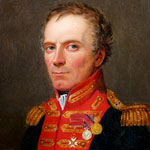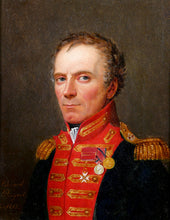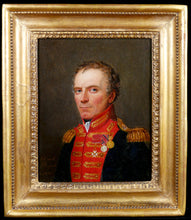Édouard-Henri-Théophile Pingret - Portrait of Colonel Adye, signed and dated August 1818
Adding product to your cart
Measurements: Overall: 32.5cm (12.75in) x 28cm (11in)
Oil on canvas. The subject is depicted quarter length in Royal Artillery 1812 pattern coatee wearing the breast badge of a Companion of the Bath, awarded to him on the recommendation of the Duke of Wellington; the Sultan’s Gold Medal for Egypt (1801); and the Waterloo Medal (1815). Canvas size: 24cm (9.5in) x 18.5cm (7.25in). Contained in a period giltwood frame. Signed by the artist ‘Edouard Pingret’ and dated ‘Auot 1818’.
The present portrait was painted in France shortly before the Congress of Aix-la-Chapelle that ended the allied occupation of France after the definitive defeat of Napoleon in June 1815. As such it may be seen as an event intended to mark the end of a career-long struggle with the forces of Revolutionary and Imperial France that culminated in the sitter’s command of the artillery of the 1st Guards Division at Quatre Bras and the Battle of Waterloo.
Read more
Major General Stephen Gallwey Adye, C.B., R.A. (1772-1838) was descended from a family of planters and administrators in St. Kitts, British West Indies. His father, Stephen Payne Adye, who served as brigade major of artillery in North America and took part in the occupation of New York City, was well known in military circles as a Deputy Judge Advocate General and author of a book on courts-martial and military punishments, which served as the standard guide for both sides during the American War of Independence. S.G. Adye followed two brothers to the Royal Military Academy at Woolwich. One of these, Ralph Willett Adye, was the author of the ‘Bombardier and Pocket Gunner’ - the artillerist’s go-to guide of the Napoleonic Wars. A third brother, John Miller Adye, entered the Royal Navy and was severely wounded in Nelson’s flagship at the Battle of the Nile. Moreover the Adye family and Nelson were known to each other from St. Kitts and shared not only common interests in plantations but also in the seizure of American shipping conducting illegal trade in the Caribbean.
Stephen Gallwey Adye was himself commissioned into the Royal Artillery on 24 April 1793. Compared with the artillery arms of continental armies of the time, the R.A. was relatively small and, as evinced by the Adyes’ service, ‘resembled a large family, close-knit and justifiably proud of its professional competence’ – a factor that set it apart from other branches of the service. Reading between the lines of Duncan’s history it appears that S.G. Adye was initially the junior subaltern of the five officers in Captain F.M. Sprowle’s No. 5 Company, 5th Battalion, R.A. Under the organisation of the time, the R.A. was divided into eight battalions each of ten companies for administrative purposes. On deployment these were generally organized in company sized ‘brigades’ of six pieces of artillery, usually comprising five guns and a howitzer.
Advanced to 1st Lieutenant on 1 June 1794 and Captain-Lieutenant on 7 April 1798, Adye was assigned to the ‘Secret Expedition’ of 1800 that having failed to take Belle-Île off the coast of Brittany, attempted the capture of the Spanish naval base at Ferrol, but was ignominiously repulsed at the Battle of Brión by the small garrison and a band of pitchfork wielding locals who became the toast of Paris.
In 1801 after a short spell of garrison duty at Gibraltar, Adye was selected for the expedition to drive the French out of Egypt. Landing with Sir Ralph Abercromby’s forces in Aboukir Bay on 8 March, he was accordingly present on the narrow spit of land in the Nile delta where on the night of the 21st General Menou’s forces counter-attacked and attempted to destroy the expeditionary force near the Roman ruins of Nicopolis.
In the hard fought battle (of Alexandria) that ensued the British prevailed at a cost of 1500 casualties, driving the bulk of the French back into the port of Alexandria. Following the death of Abercromby from wounds, Adye was involved on 9 May in the action at Ramanieh when the new British commander attempted to by-pass 4000 French entrenched in a fortified camp to reach the Ottoman forces under the Grand Vizier besieging Cairo. During this encounter Adye pushed his guns into an exposed position to best contain the enemy’s ‘superior weight of metal’ and cover their batteries. His commanding officer lost a leg to chance shot and died a month later at Rosetta, while Adye was listed among the wounded.
Following the reduction of outlying fortifications, the siege finally ended on 2 September with the surrender of the garrison who were permitted to return to France. Meanwhile Adye was one of five artillery officers who were Mentioned in Despatches, and in addition received Sultan Selim III’s Gold Medal for Egypt from the Grand Vizier Kör Yusuf Ziyaüddin Pasha.
With the dispersal of the expedition, Adye returned with his company to Gibraltar and thence to Ireland, where by special order of October 1803, he and other veterans of his were given permission to display the honours of the campaign in the form of Sphynx badge and the word ‘EGYPT’ on their regimental caps. These honours however were ‘personal’ and not to be perpetuated in the company. Promoted Captain 1 May 1803, he officially succeeded Sprowle to the command of No. 5 Company, 5th Battalion; remaining in the appointment until 1812.
In 1809 he served as Brigade Major in the Walcheren Expedition to help the Austrians open a second front in the Netherlands against France, but while away on this abortive campaign his wife Mary died and she was interred beneath a stone in St Mary’s church, Woolwich. Despite the failure of the Walcheren enterprise Adye was again favourably Mentioned in Despatches and appointed Brevet Major on 25 July 1810.
Adye was next present at Cadiz in support of the Anglo-Spanish garrison besieged by some 70,000 French under Marshals Soult and Victor until their withdrawal following Wellington’s victory at Salamanca on 22 July 1812. Advanced to Major 1 October 1812, Adye served in the Peninsula Army from April 1813 until the defeat of France and Napoleon’s exile to Elba. He became Lieutenant Colonel on Christmas Day 1814 and following Napoleon’s escape in February 1815 joined the allied army in the Netherlands as commander of the artillery attached to the 1st Guards Division in H.R.H. The Prince of Orange’s I Corps - his immediate command comprising some 15 officers and 401 men divided between Sandham’s Battery, Royal Field Artillery and Kuhlmann’s Troop, King’s German Legion Horse Artillery. On 15 June at Quatre Bras Adye’s artillery came under Wellington’s direct orders when it became necessary for Kuhlmann’s horse artillery to deploy across the Namur road and engage cavalry harrying the rearguard as the allied army fell back on Waterloo. On the 17th as the retreat continued Adye was again in action halting his guns and breaking up the enemy’s determined pursuit.
On the morning of the 18th the ground was so sodden that it was scarcely possible to move Adye’s 9-pounder cannon and 5.5 inch howtitzers, which the Prince of Orange directed to a position on the escarpment in front of the Foot Guards and with Château d'Hougoumont some 600 paces below to the right front. According to Kuhlmann before the battle was joined the Duke of Wellington visited the batteries and gave ‘the distinct order never to fire at the enemy artillery’. Thus Adye waited and opened up at the advance of a strong column of infantry towards Hougoumont with ‘a powerful fire of ball and shrapnel’ repeatedly breaking the formation and forcing it back in disorder until it finally moved behind Hougoumont where it occupied an area outside the walls. This presumably was the initial attack by Maréchal de Camp Bauduin's 1st Brigade of the 6th Division that emptied the wood and park, but was driven back by heavy British artillery fire that cost Bauduin his life. The Prince of Orange was vociferous in his approval and complimented the British and German gunners in a loud voice for their well aimed and effective fire.
At this point a French heavy battery with large calibre guns moved up and opened fire 1200 paces to their front but owing to the Duke’s earlier order, as recorded by Kuhlmann, Adye was prevented from responding. Other accounts have it that the British guns were distracted into an artillery duel with French guns which allowed a second attack by Maréchal de Camp Baron Soye's 2nd Brigade of the 6th Division to develop.
Later as the afternoon drew on enemy cavalry broke through the line some distance to the left and concealed from view for sometime, unexpectedly fell upon Adye’s flank, compelling the rapid retreat of both batteries. Once safety was reached Adye redistributed the available ammunition and took both batteries back to the gun line, whence it was found the enemy was in full retreat and the day was won. Casualties in Adye’s command numbered sixty-three killed, wounded and missing. The night following was spent bivouacked among the carnage of the battlefield on the Nivelles road.
Édouard-Henri-Théophile Pingret (1788-1875) was the son of a lawyer from St. Quentin with family connections to the local Protestant nobility, but who nevertheless became the Representative of the Department Aisne at the Revolutionary Convention. Citizen Pingret’s political duties brought him to Paris where Édouard studied under the greatest history painters of the Napoleonic age, Jean-Baptiste Regnault (1754-1829) and Jacques-Louis David (1748-1825), and also at the Accademia di San Luca in Rome. Specializing in portraiture, Pingret launched his career with a painting of the Emperor in 1808, and exhibited in Paris salons from 1810 onward.
After Waterloo he tapped into the ready market for portraiture amongst British officers serving with the Army of Occupation. Meanwhile in early 1819 a growing fashion for all things French in England led Pingret, like Géricault, Delacroix and Horace Vernet, to visit London to take advantage of all that the capital had to offer. By the time he returned to France his ability to capture likenesses quickly and expeditiously had been fully proven. In the 1830s he was associated with the Romantic movement, exhibiting a full length portrait of violin virtuoso Paganini at the 1831 Salon and receiving the Legion d’Honneur the same year. In the 1850’s he moved to Mexico City where he inspired local artists to emulate the standards of European portraiture. However his most important works in Mexico were his scenes of everyday life. He died in his home town of Saint-Quentin.
Stephen Galway Adye survived to become a Major General in 1837 while holding the post of Superintendent of the Royal Laboratory, the ammunition research and manufacturing facility at Woolwich Arsenal. In the same year he sat to William Salter the artist charged with executing a pictorial record of the annual Waterloo Banquet at Apsley House as it appeared in 1836. Salter’s preparatory portrait of Adye (NPG 369) can be found in the Primary Collection of the National Portrait Gallery. However before the completed work, now hanging in Apsley House, was finished, Adye died and was interred with his wife at St. Mary’s, Woolwich.
Reference sources:
Adye - 'Pedigree of Adye of St. Kitts', Caribbeana, Vol. 2 (1912):p. 242-250
Browne, J.A. (1865) ‘England's Artillerymen: An Historical Narrative of the Services of the Royal Artillery’, Hall, Smart & Allen, London
Challis, Lionel S. ‘Peninsula Roll Call’
Duncan, Maj. F. (1872) ‘History of the Royal Regiment of Artillery’, Vol. II (1784-1815), London
Gentleman’s Magazine, Dec. 1838, p.659
Glover, G. (2010) ‘Waterloo Archive, Volume II: German Sources’, Frontline Books
Haythornthwaite, P. & Fosten B. (1999) ‘Wellington’s Specialist Troops’, Osprey Publishing, Oxford
Kane, J. (1815) ‘List of Officers of the Royal Regiment of Artillery’, E. Delahoy, Greenwich
Scots Magazine (1801) Vol. LXIII, Chapman & Co., Edinburgh, p. 508, ‘Rhamanieh, May 9. 1801. Return of Killed and wounded …’
Sugden, J. (2012 edn.) ‘Nelson: A Dream of Glory’, Random House, London






